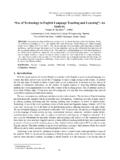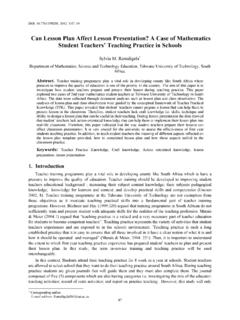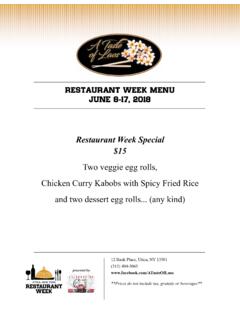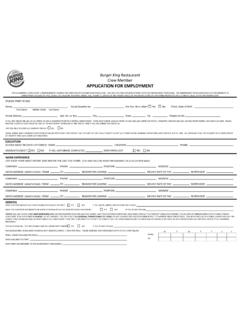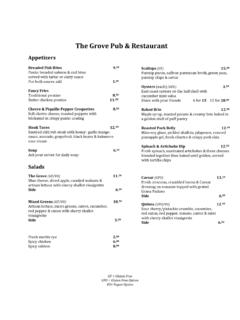Transcription of Case Study for Restaurant Queuing Model - IPEDR
1 case Study for Restaurant Queuing Model Mathias Dharmawirya School of Information Systems Binus International Binus University Jakarta, Indonesia Erwin Adi School of Computer Science Binus International Binus University Jakarta, Indonesia Abstract Restaurants would avoid losing their customers due to a long wait on the line. Some restaurants initially provide more waiting chairs than they actually need to put them in the safe side, and reducing the chairs as the time goes on safe space. However, waiting chairs alone would not solve a problem when customers withdraw and go to the competitor s door; the service time may need to be improved. This shows a need of a numerical Model for the Restaurant management to understand the situation better. This paper aims to show that Queuing theory satisfies the Model when tested with a real- case scenario.
2 We obtained the data from a Restaurant in Jakarta. We then derive the arrival rate, service rate, utilization rate, waiting time in queue and the probability of potential customers to balk based on the data using Little s Theorem and M/M/1 Queuing Model . The arrival rate at Sushi Tei during its busiest period of the day is customers per minute (cpm) while the service rate is cpm. The average number of customers in the Restaurant is 122 and the utilization period is We conclude the paper by discussing the benefits of performing Queuing analysis to a busy Restaurant . Keywords Queue; Little s Theorem; Restaurant ; Waiting Lines I. INTRODUCTION There are several determining factors for a Restaurant to be considered a good or a bad one. Taste, cleanliness, the Restaurant layout and settings are some of the most important factors.
3 These factors, when managed carefully, will be able to attract plenty of customers. However, there is also another factor that needs to be considered especially when the Restaurant has already succeeded in attracting customers. This factor is the customers Queuing time. Queuing theory is the Study of queue or waiting lines. Some of the analysis that can be derived using Queuing theory include the expected waiting time in the queue, the average time in the system, the expected queue length, the expected number of customers served at one time, the probability of balking customers, as well as the probability of the system to be in certain states, such as empty or full. Waiting lines are a common sight in restaurants especially during lunch and dinner time. Hence, Queuing theory is suitable to be applied in a Restaurant setting since it has an associated queue or waiting line where customers who cannot be served immediately have to queue (wait) for service.
4 Researchers have previously used Queuing theory to Model the Restaurant operation [2], reduce cycle time in a busy fast food Restaurant [3], as well as to increase throughput and efficiency [5]. This paper uses Queuing theory to Study the waiting lines in Sushi Tei Restaurant at Senayan City, Jakarta. The Restaurant provides 20 tables of 6 people. There are 8 to 9 waiters or waitresses working at any one time. On a daily basis, it serves over 400 customers during weekdays, and over 1000 customers during weekends. This paper seeks to illustrate the usefulness of applying Queuing theory in a real- case situation. II. Queuing THEORY In 1908, Copenhagen Telephone Company requested Agner K. Erlang to work on the holding times in a telephone switch. He identified that the number of telephone conversations and telephone holding time fit into Poisson distribution and exponentially distributed.
5 This was the beginning of the Study of Queuing theory. In this section, we will discuss two common concepts in Queuing theory. A. Little s Theorem Little s theorem [7] describes the relationship between throughput rate ( arrival and service rate), cycle time and work in process ( number of customers/jobs in the system). This relationship has been shown to be valid for a wide class of Queuing models. The theorem states that the expected number of customers (N) for a system in steady state can be determined using the following equation: (1) Here, is the average customer arrival rate and T is the average service time for a customer. Consider the example of a Restaurant where the customer s arrival rate ( ) doubles but the customers still spend the same amount of time in the Restaurant (T).
6 These facts will double the number of customers in the Restaurant (L). By the same logic, if the customer arrival rate ( ) remains the same but the customers service time doubles this will also double the total number of customers in the Restaurant . This indicates that in order to control the three variables, managerial decisions are only required for any two of the three variables. Three fundamental relationships can be derived from Little s theorem [6]: L increases if or T increases increases if L increases or T decreases T increases if L increases or decreases 522011 International Conference on Management and Artificial Intelligence IPEDR (2011) (2011)IACSIT Press, Bali, Indonesia Rust [8] said that the Little s theorem can be useful in quantifying the maximum achievable operational improvements and also to estimate the performance change when the system is modified.
7 B. Queuing Models and Kendall s Notation In most cases, Queuing models can be characterized by the following factors: Arrival time distribution. Inter-arrival times most commonly fall into one of the following distribution patterns: a Poisson distribution, a Deterministic distribution, or a General distribution. However, inter-arrival times are most often assumed to be independent and memoryless, which is the attributes of a Poisson distribution. Service time distribution. The service time distribution can be constant, exponential, hyper-exponential, hypo-exponential or general. The service time is independent of the inter-arrival time. Number of servers. The Queuing calculations change depends on whether there is a single server or multiple servers for the queue. A single server queue has one server for the queue.
8 This is the situation normally found in a grocery store where there is a line for each cashier. A multiple server queue corresponds to the situation in a bank in which a single line waits for the first of several tellers to become available. Queue Lengths (optional). The queue in a system can be modeled as having infinite or finite queue length. System capacity (optional). The maximum number of customers in a system can be from 1 up to infinity. This includes the customers waiting in the queue. Queuing discipline (optional). There are several possibilities in terms of the sequence of customers to be served such as FIFO (First In First Out, in order of arrival), random order, LIFO (Last In First Out, the last one to come will be the first to be served), or priorities.
9 Kendall, in 1953, proposed a notation system to represent the six characteristics discussed above. The notation of a queue is written as: A/B/P/Q/R/Z where A, B, P, Q, R and Z describe the Queuing system properties. A describes the distribution type of the inter arrival times. B describes the distribution type of the service times. P describes the number of servers in the system. Q (optional) describes the maximum length of the queue. R (optional) describes the size of the system population. Z (optional) describes the Queuing discipline. III. SUSHI TEI Queuing Model The data were obtained from Sushi Tei through interview with the Restaurant manager as well as data collections through observations at the Restaurant . The daily number of visitors was obtained from the Restaurant itself.
10 The Restaurant has been recording the data as part of its end of day routine. We also interviewed the Restaurant manager to find out about the capacity of the Restaurant , the number of waiters and waitresses, as well as the number of chefs in the Restaurant . Based on the interview with the Restaurant manager, we concluded that the Queuing Model that best illustrate the operation of Sushi Tei is M/M/1. This means that the arrival and service time are exponentially distributed (Poisson process). The Restaurant system consists of only one server. In our observation the Restaurant has several waitresses but in the actual waiting queue, they only have one chef to serve all of the customers. Figure 1 illustrates the M/M/1 Queuing Model . Figure 1. M/M/1 Queuing Model For the analysis of the Sushi Tei M/M/1 Queuing Model , the following variables will be investigated [6]: : The mean customers arrival rate : The mean service rate : / : utilization factor Probability of zero customers in the Restaurant : P0 = 1 (2) Pn : The probability of having n customers in the Restaurant .
